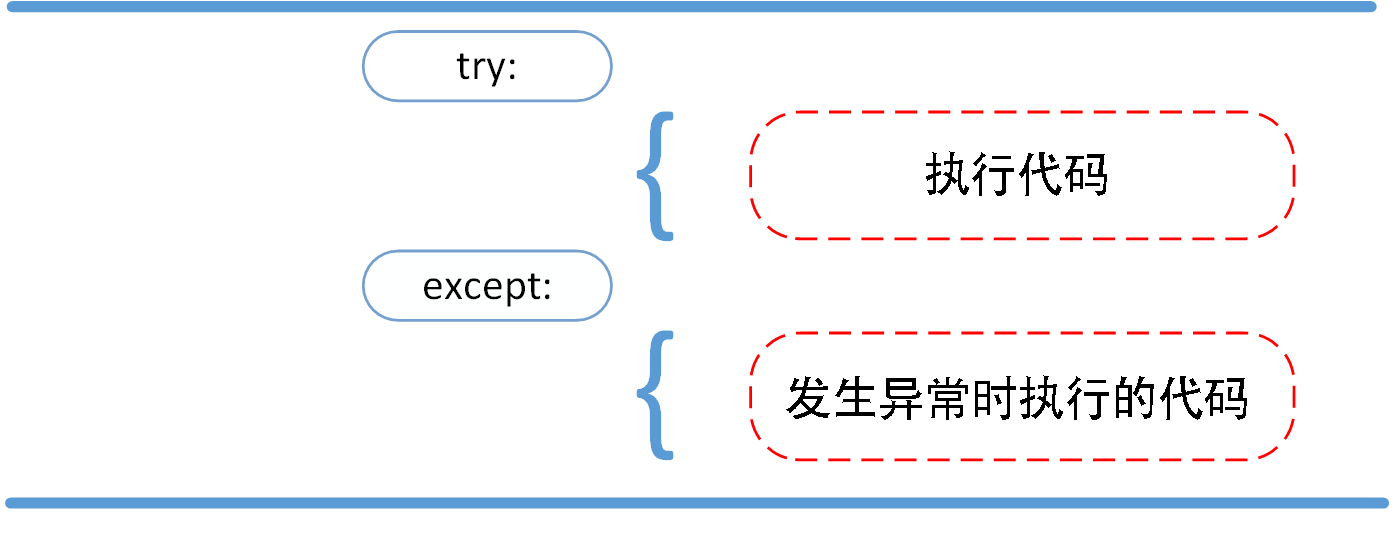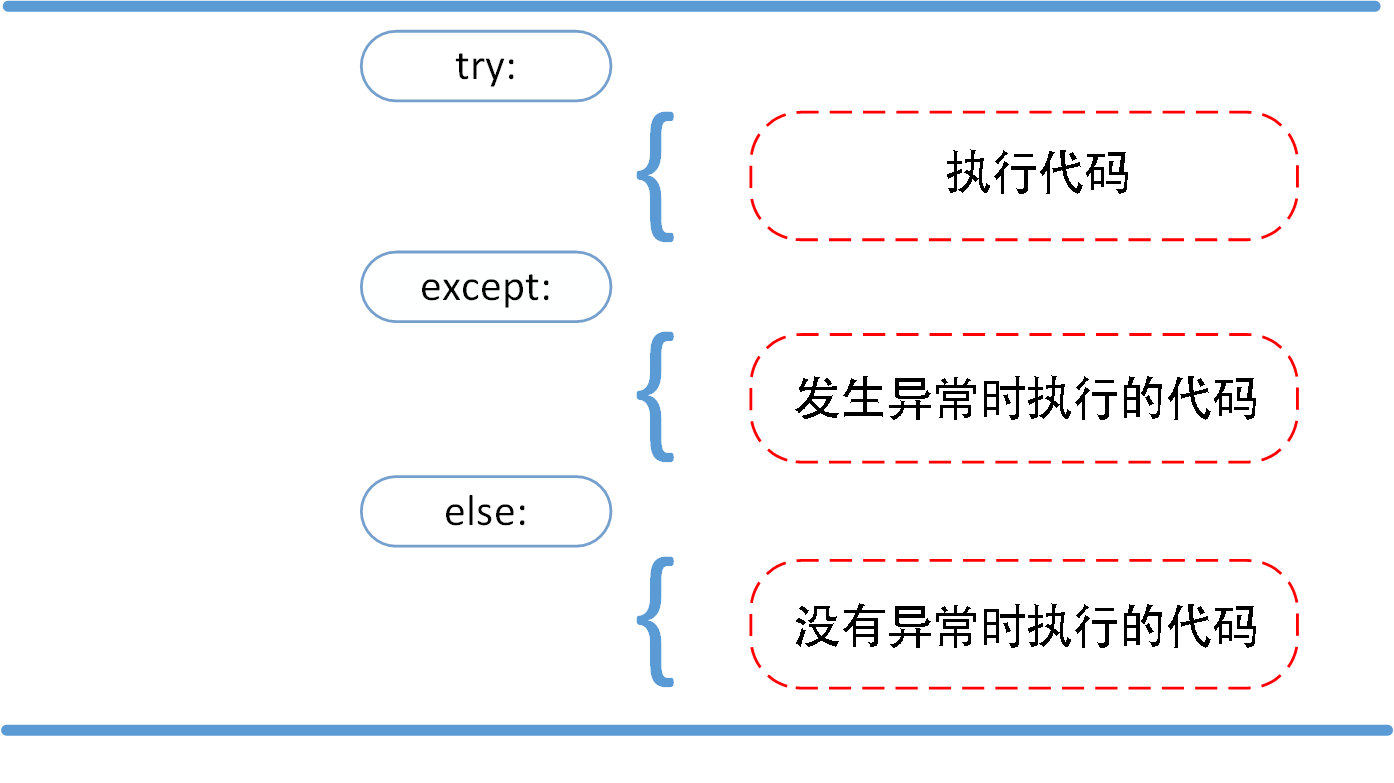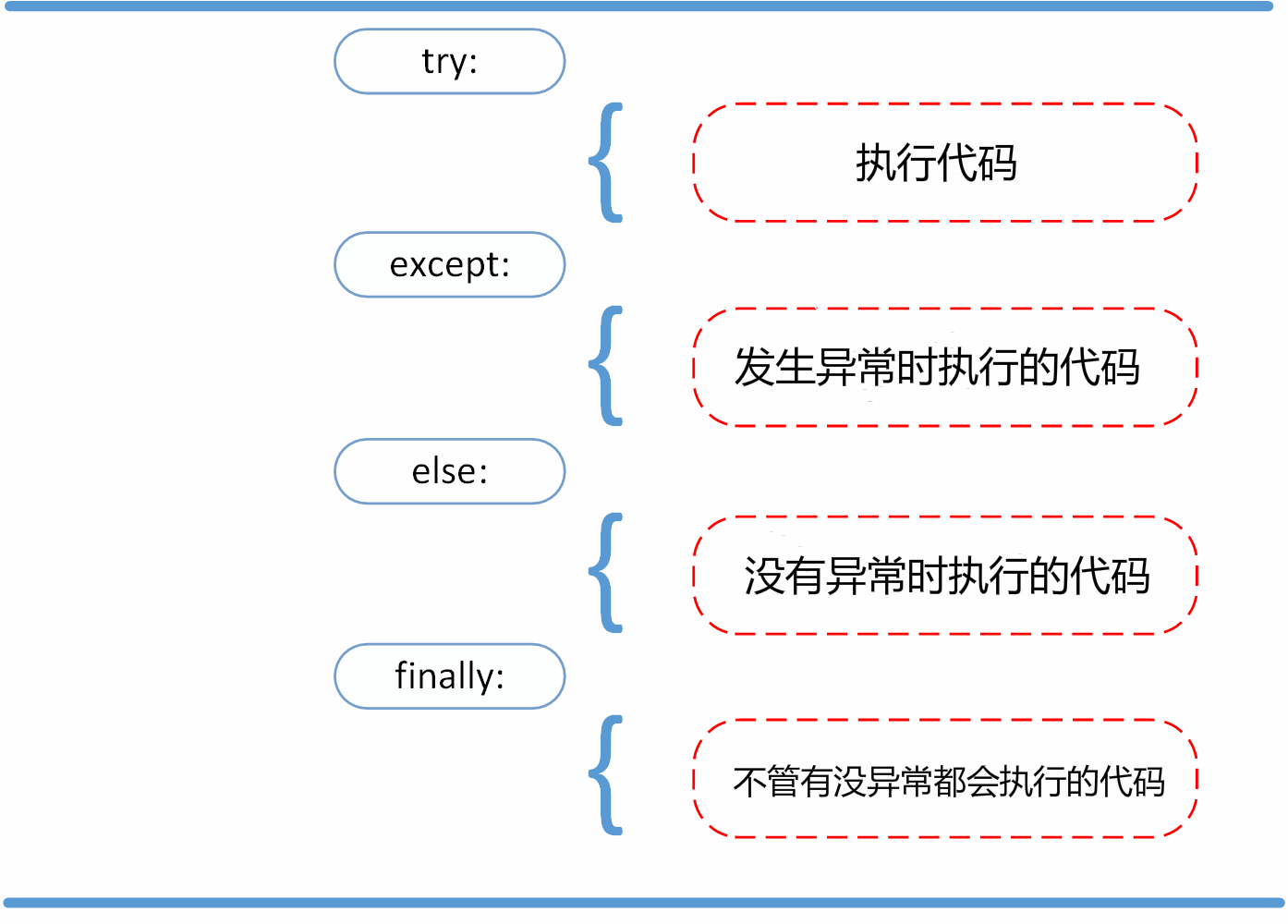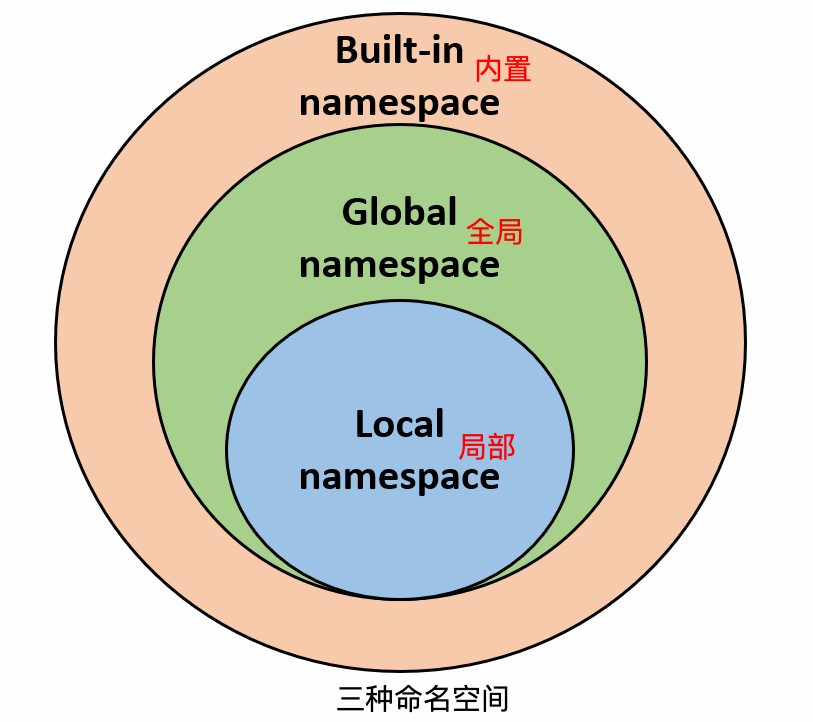Python3 错误和异常
- 异常处理try/except

try 语句按照如下方式工作:
- 首先,执行 try 子句(在关键字 try 和关键字 except 之间的语句)。
- 如果没有异常发生,忽略 except 子句,try 子句执行后结束。
- 如果在执行 try 子句的过程中发生了异常,那么 try 子句余下的部分将被忽略。如果异常的类型和 except 之后的名称相符,那么对应的 except 子句将被执行。
- 如果一个异常没有与任何的 excep 匹配,那么这个异常将会传递给上层的 try 中。
最后一个except子句可以忽略异常的名称,它将被当作通配符使用。你可以使用这种方法打印一个错误信息,然后再次把异常抛出。
import sys
try:
f = open('myfile.txt')
s = f.readline()
i = int(s.strip())
except OSError as err:
print("OS error: {0}".format(err))
except ValueError:
print("Could not convert data to an integer.")
except:
print("Unexpected error:", sys.exc_info()[0])
raise
- try/except...else

for arg in sys.argv[1:]:
try:
f = open(arg, 'r')
except IOError:
print('cannot open', arg)
else:
print(arg, 'has', len(f.readlines()), 'lines')
f.close()
- try-finally 语句

实例
try:
runoob()
except AssertionError as error:
print(error)
else:
try:
with open('file.log') as file:
read_data = file.read()
except FileNotFoundError as fnf_error:
print(fnf_error)
finally:
print('这句话,无论异常是否发生都会执行。')
- 抛出异常
//Python 使用 raise 语句抛出一个指定的异常。
raise [Exception [, args [, traceback]]]
Python3 面向对象
- 面向对象技术简介
- 类(Class): 用来描述具有相同的属性和方法的对象的集合。它定义了该集合中每个对象所共有的属性和方法。对象是类的实例。
- 方法:类中定义的函数。
- 类变量:类变量在整个实例化的对象中是公用的。类变量定义在类中且在函数体之外。类变量通常不作为实例变量使用。
- 数据成员:类变量或者实例变量用于处理类及其实例对象的相关的数据。
- 方法重写:如果从父类继承的方法不能满足子类的需求,可以对其进行改写,这个过程叫方法的覆盖(override),也称为方法的重写。
- 局部变量:定义在方法中的变量,只作用于当前实例的类。
- 实例变量:在类的声明中,属性是用变量来表示的,这种变量就称为实例变量,实例变量就是一个用 self 修饰的变量。
- 继承:即一个派生类(derived class)继承基类(base class)的字段和方法。继承也允许把一个派生类的对象作为一个基类对象对待。例如,有这样一个设计:一个Dog类型的对象派生自Animal类,这是模拟"是一个(is-a)"关系(例图,Dog是一个Animal)。
- 实例化:创建一个类的实例,类的具体对象。
- 对象:通过类定义的数据结构实例。对象包括两个数据成员(类变量和实例变量)和方法。
- 类对象
类对象支持两种操作:属性引用和实例化。 属性引用使用和 Python 中所有的属性引用一样的标准语法:obj.name。
class MyClass:
"""一个简单的类实例"""
i = 12345
def f(self):
return 'hello world'
# 实例化类
x = MyClass()
# 访问类的属性和方法
print("MyClass 类的属性 i 为:", x.i)
print("MyClass 类的方法 f 输出为:", x.f())
- 构造方法
//该方法在类实例化时会自动调用
def __init__(self):
self.data = []
注:self代表类的实例,而非类
- 类的方法
//在类的内部,使用 def 关键字来定义一个方法,与一般函数定义不同,类方法必须包含参数 self, 且为第一个参数,self 代表的是类的实例。
#类定义
class people:
#定义基本属性
name = ''
age = 0
#定义私有属性,私有属性在类外部无法直接进行访问
__weight = 0
#定义构造方法
def __init__(self,n,a,w):
self.name = n
self.age = a
self.__weight = w
def speak(self):
print("%s 说: 我 %d 岁。" %(self.name,self.age))
# 实例化类
p = people('runoob',10,30)
p.speak()
- 继承
需要注意圆括号中基类的顺序,若是基类中有相同的方法名,而在子类使用时未指定,python从左至右搜索 即方法在子类中未找到时,从左到右查找基类中是否包含方法。 BaseClassName(示例中的基类名)必须与派生类定义在一个作用域内。除了类,还可以用表达式,基类定义在另一个模块中时这一点非常有用:
#类定义
class people:
#定义基本属性
name = ''
age = 0
#定义私有属性,私有属性在类外部无法直接进行访问
__weight = 0
#定义构造方法
def __init__(self,n,a,w):
self.name = n
self.age = a
self.__weight = w
def speak(self):
print("%s 说: 我 %d 岁。" %(self.name,self.age))
#单继承示例
class student(people):
grade = ''
def __init__(self,n,a,w,g):
#调用父类的构函
people.__init__(self,n,a,w)
self.grade = g
#覆写父类的方法
def speak(self):
print("%s 说: 我 %d 岁了,我在读 %d 年级"%(self.name,self.age,self.grade))
s = student('ken',10,60,3)
s.speak()
- 多继承
class DerivedClassName(Base1, Base2, Base3):
<statement-1>
.
.
.
<statement-N>
需要注意圆括号中父类的顺序,若是父类中有相同的方法名,而在子类使用时未指定,python从左至右搜索 即方法在子类中未找到时,从左到右查找父类中是否包含方法。

#!/usr/bin/python3 #类定义 class people: #定义基本属性 name = '' age = 0 #定义私有属性,私有属性在类外部无法直接进行访问 __weight = 0 #定义构造方法 def __init__(self,n,a,w): self.name = n self.age = a self.__weight = w def speak(self): print("%s 说: 我 %d 岁。" %(self.name,self.age)) #单继承示例 class student(people): grade = '' def __init__(self,n,a,w,g): #调用父类的构函 people.__init__(self,n,a,w) self.grade = g #覆写父类的方法 def speak(self): print("%s 说: 我 %d 岁了,我在读 %d 年级"%(self.name,self.age,self.grade)) #另一个类,多重继承之前的准备 class speaker(): topic = '' name = '' def __init__(self,n,t): self.name = n self.topic = t def speak(self): print("我叫 %s,我是一个演说家,我演讲的主题是 %s"%(self.name,self.topic)) #多重继承 class sample(speaker,student): a ='' def __init__(self,n,a,w,g,t): student.__init__(self,n,a,w,g) speaker.__init__(self,n,t) test = sample("Tim",25,80,4,"Python") test.speak() #方法名同,默认调用的是在括号中排前地父类的方法
- 方法重写
如果你的父类方法的功能不能满足你的需求,你可以在子类重写你父类的方法,实例如下:
class Parent: # 定义父类
def myMethod(self):
print ('调用父类方法')
class Child(Parent): # 定义子类
def myMethod(self):
print ('调用子类方法')
c = Child() # 子类实例
c.myMethod() # 子类调用重写方法
super(Child,c).myMethod() #用子类对象调用父类已被覆盖的方法
- 类属性与方法
- __private_attrs:两个下划线开头,声明该属性为私有,不能在类的外部被使用或直接访问。在类内部的方法中使用时 self.__private_attrs。
- 类的方法: 在类的内部,使用 def 关键字来定义一个方法,与一般函数定义不同,类方法必须包含参数 self,且为第一个参数,self 代表的是类的实例。 self 的名字并不是规定死的,也可以使用 this,但是最好还是按照约定是用 self。
- 类的私有方法 __private_method:两个下划线开头,声明该方法为私有方法,只能在类的内部调用 ,不能在类的外部调用。self.__private_methods。
//私有属性
class JustCounter:
__secretCount = 0 # 私有变量
publicCount = 0 # 公开变量
def count(self):
self.__secretCount += 1
self.publicCount += 1
print (self.__secretCount)
counter = JustCounter()
counter.count()
counter.count()
print (counter.publicCount)
print (counter.__secretCount) # 报错,实例不能访问私有变量
//私有方法
class Site:
def __init__(self, name, url):
self.name = name # public
self.__url = url # private
def who(self):
print('name : ', self.name)
print('url : ', self.__url)
def __foo(self): # 私有方法
print('这是私有方法')
def foo(self): # 公共方法
print('这是公共方法')
self.__foo()
x = Site('菜鸟教程', 'www.runoob.com')
x.who() # 正常输出
x.foo() # 正常输出
x.__foo() # 报错
- 类的专有方法:
| 方法 | 描述 |
|---|---|
| __init__ | 构造函数,在生成对象时调用 |
| __del__ | 析构函数,释放对象时使用 |
| __repr__ | 打印,转换 |
| __setitem__ | 按照索引赋值 |
| __getitem__ | 按照索引获取值 |
| __len__ | 获得长度 |
| __cmp__ | 比较运算 |
| __call__ | 函数调用 |
| __add__ | 加运算 |
| __sub__ | 减运算 |
| __mul__ | 乘运算 |
| __truediv__ | 除运算 |
| __mod__ | 求余运算 |
| __pow__ | 乘方 |
Python3 命名空间和作用域
- 命名空间
命名空间(Namespace)是从名称到对象的映射,大部分的命名空间都是通过 Python 字典来实现的。 命名空间提供了在项目中避免名字冲突的一种方法。各个命名空间是独立的,没有任何关系的,所以一个命名空间中不能有重名,但不同的命名空间是可以重名而没有任何影响。
- 内置名称(built-in names), Python 语言内置的名称,比如函数名 abs、char 和异常名称 BaseException、Exception 等等。
- 全局名称(global names),模块中定义的名称,记录了模块的变量,包括函数、类、其它导入的模块、模块级的变量和常量。
- 局部名称(local names),函数中定义的名称,记录了函数的变量,包括函数的参数和局部定义的变量。(类中定义的也是)

Python 的查找顺序为:局部的命名空间去 -> 全局命名空间 -> 内置命名空间。
- 作用域
- L(Local):最内层,包含局部变量,比如一个函数/方法内部。
- E(Enclosing):包含了非局部(non-local)也非全局(non-global)的变量。比如两个嵌套函数,一个函数(或类) A 里面又包含了一个函数 B ,那么对于 B 中的名称来说 A 中的作用域就为 nonlocal。
- G(Global):当前脚本的最外层,比如当前模块的全局变量。
- B(Built-in): 包含了内建的变量/关键字等。,最后被搜索
注:规则顺序: L –> E –> G –>gt; B。

g_count = 0 # 全局作用域
def outer():
o_count = 1 # 闭包函数外的函数中
def inner():
i_count = 2 # 局部作用域
- 全局变量和局部变量
total = 0 # 这是一个全局变量
# 可写函数说明
def sum( arg1, arg2 ):
#返回2个参数的和."
total = arg1 + arg2 # total在这里是局部变量.
print ("函数内是局部变量 : ", total)
return total
#调用sum函数
sum( 10, 20 )
print ("函数外是全局变量 : ", total)
- global 和 nonlocal关键字
当内部作用域想修改外部作用域的变量时,就要用到global和nonlocal关键字了。
num = 1
def fun1():
global num # 需要使用 global 关键字声明
print(num)
num = 123
print(num)
fun1()
print(num)
Python3 标准库概览
- 操作系统接口
>>> import os
>>> os.getcwd() # 返回当前的工作目录
'C:\Python34'
>>> os.chdir('/server/accesslogs') # 修改当前的工作目录
>>> os.system('mkdir today') # 执行系统命令 mkdir
0
//针对日常的文件和目录管理任务,:mod:shutil 模块提供了一个易于使用的高级接口:
>>> import shutil
>>> shutil.copyfile('data.db', 'archive.db')
>>> shutil.move('/build/executables', 'installdir')
- 文件通配符
//glob模块提供了一个函数用于从目录通配符搜索中生成文件列表:
>>> import glob
>>> glob.glob('*.py')
['primes.py', 'random.py', 'quote.py']
- 命令行参数
//通用工具脚本经常调用命令行参数。这些命令行参数以链表形式存储于 sys 模块的 argv 变量。例如在命令行中执行 "python demo.py one two three" 后可以得到以下输出结果:
>>> import sys
>>> print(sys.argv)
['demo.py', 'one', 'two', 'three']
- 错误输出重定向和程序终止
#sys 还有 stdin,stdout 和 stderr 属性,即使在 stdout 被重定向时,后者也可以用于显示警告和错误信息。
>>> sys.stderr.write('Warning, log file not found starting a new one
')
Warning, log file not found starting a new one
- 字符串正则匹配
#re模块为高级字符串处理提供了正则表达式工具。对于复杂的匹配和处理,正则表达式提供了简洁、优化的解决方案:
>>> import re
>>> re.findall(r'f[a-z]*', 'which foot or hand fell fastest')
['foot', 'fell', 'fastest']
>>> re.sub(r'([a-z]+) 1', r'1', 'cat in the the hat')
'cat in the hat'
>>> 'tea for too'.replace('too', 'two')
'tea for two'
- 数学
math模块为浮点运算提供了对底层C函数库的访问:
>>> import math
>>> math.cos(math.pi / 4)
0.70710678118654757
>>> math.log(1024, 2)
10.0
random提供了生成随机数的工具。
>>> import random
>>> random.choice(['apple', 'pear', 'banana'])
'apple'
>>> random.sample(range(100), 10) # sampling without replacement
[30, 83, 16, 4, 8, 81, 41, 50, 18, 33]
>>> random.random() # random float
0.17970987693706186
>>> random.randrange(6) # random integer chosen from range(6)
4
- 访问互联网
有几个模块用于访问互联网以及处理网络通信协议。其中最简单的两个是用于处理从 urls 接收的数据的 urllib.request 以及用于发送电子邮件的 smtplib:
>>> from urllib.request import urlopen
>>> for line in urlopen('http://tycho.usno.navy.mil/cgi-bin/timer.pl'):
... line = line.decode('utf-8') # Decoding the binary data to text.
... if 'EST' in line or 'EDT' in line: # look for Eastern Time
... print(line)
<BR>Nov. 25, 09:43:32 PM EST
>>> import smtplib
>>> server = smtplib.SMTP('localhost')
>>> server.sendmail('soothsayer@example.org', 'jcaesar@example.org',
... """To: jcaesar@example.org
... From: soothsayer@example.org
...
... Beware the Ides of March.
... """)
>>> server.quit()
- 日期和时间
datetime模块为日期和时间处理同时提供了简单和复杂的方法。 支持日期和时间算法的同时,实现的重点放在更有效的处理和格式化输出。 该模块还支持时区处理:
- 常用时间处理方法
- 今天 today = datetime.date.today()
- 昨天 yesterday = today - datetime.timedelta(days=1)
- 上个月 last_month = today.month - 1 if today.month - 1 else 12
- 当前时间戳 time_stamp = time.time()
- 时间戳转datetime datetime.datetime.fromtimestamp(time_stamp)
- datetime转时间戳 int(time.mktime(today.timetuple()))
- datetime转字符串 today_str = today.strftime("%Y-%m-%d")
- 字符串转datetime today = datetime.datetime.strptime(today_str, "%Y-%m-%d")
- 补时差 today + datetime.timedelta(hours=8)
>>> # dates are easily constructed and formatted
>>> from datetime import date
>>> now = date.today()
>>> now
datetime.date(2003, 12, 2)
>>> now.strftime("%m-%d-%y. %d %b %Y is a %A on the %d day of %B.")
'12-02-03. 02 Dec 2003 is a Tuesday on the 02 day of December.'
>>> # dates support calendar arithmetic
>>> birthday = date(1964, 7, 31)
>>> age = now - birthday
>>> age.days
14368
- 数据压缩
以下模块直接支持通用的数据打包和压缩格式:zlib,gzip,bz2,zipfile,以及 tarfile。
>>> import zlib
>>> s = b'witch which has which witches wrist watch'
>>> len(s)
41
>>> t = zlib.compress(s)
>>> len(t)
37
>>> zlib.decompress(t)
b'witch which has which witches wrist watch'
>>> zlib.crc32(s)
226805979
- 性能度量
>>> from timeit import Timer
>>> Timer('t=a; a=b; b=t', 'a=1; b=2').timeit()
0.57535828626024577
>>> Timer('a,b = b,a', 'a=1; b=2').timeit()
0.54962537085770791
- 测试模块
开发高质量软件的方法之一是为每一个函数开发测试代码,并且在开发过程中经常进行测试 doctest模块提供了一个工具,扫描模块并根据程序中内嵌的文档字符串执行测试。
def average(values):
"""Computes the arithmetic mean of a list of numbers.
>>> print(average([20, 30, 70]))
40.0
"""
return sum(values) / len(values)
import doctest
doctest.testmod() # 自动验证嵌入测试
#unittest模块不像 doctest模块那么容易使用,不过它可以在一个独立的文件里提供一个更全面的测试集:
import unittest
class TestStatisticalFunctions(unittest.TestCase):
def test_average(self):
self.assertEqual(average([20, 30, 70]), 40.0)
self.assertEqual(round(average([1, 5, 7]), 1), 4.3)
self.assertRaises(ZeroDivisionError, average, [])
self.assertRaises(TypeError, average, 20, 30, 70)
unittest.main() # Calling from the command line invokes all tests
- urlopen
#处理get请求,不传data,则为get请求
import urllib
from urllib.request import urlopen
from urllib.parse import urlencode
url='http://www.xxx.com/login'
data={"username":"admin","password":123456}
req_data=urlencode(data)#将字典类型的请求数据转变为url编码
res=urlopen(url+'?'+req_data)#通过urlopen方法访问拼接好的url
res=res.read().decode()#read()方法是读取返回数据内容,decode是转换返回数据的bytes格式为str
print(res)
#处理post请求,如果传了data,则为post请求
import urllib
from urllib.request import Request
from urllib.parse import urlencode
url='http://www.xxx.com/login'
data={"username":"admin","password":123456}
data=urlencode(data)#将字典类型的请求数据转变为url编码
data=data.encode('ascii')#将url编码类型的请求数据转变为bytes类型
req_data=Request(url,data)#将url和请求数据处理为一个Request对象,供urlopen调用
with urlopen(req_data) as res:
res=res.read().decode()#read()方法是读取返回数据内容,decode是转换返回数据的bytes格式为str
print(res)
